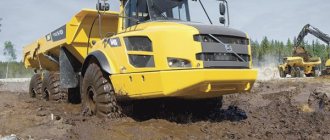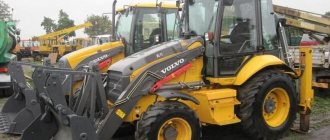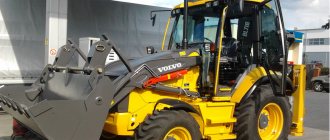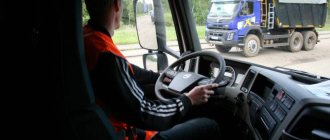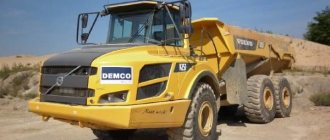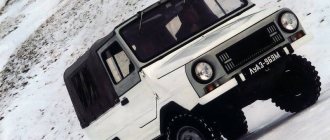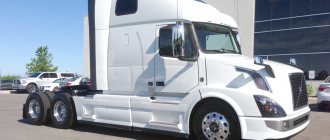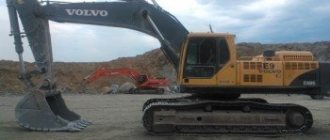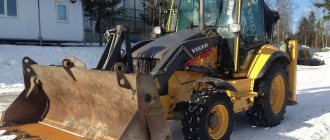Domestic “loaves” and military UAZs were highly competitive with the legendary Swedish army SUV under the telling name “Volvo-Laplander”. The car got its name based on its geographical aspect. Laplanders are a small ethnic group of hunters and reindeer herders living in several states in northern Europe. Some northerners also call the wild inhabitants of the forest this way.
Moments of history
The army truck has been produced since the mid-twentieth century, when the Volvo corporation mastered the military order for the needs of the Swedish army. The starting prototypes of the Volvo Laplander SUV are dated 1959 and marked with the L230 index. The basis for the new car was the Amazon version, from which the power unit was borrowed - a 1.6-liter B16 gasoline engine. The initial production samples met the following characteristics:
- Cast iron motor with 65 horsepower.
- Centrally located power unit.
- The Volvo-Laplander axles had permanent rear and front-wheel drive that can be switched off.
- Four-speed gearbox, M-40.
At first, the name of the car in question sounded like Volvo Valp - “Volvo puppy”. The armed forces of Norway and neighboring countries have shown interest in this SUV. And already in the 60s, white “Laplanders” appeared in the service of the United Nations. The vehicle had several modifications: an anti-tank model, a medical version and a cargo version. The most popular car in its category, the Volvo C303, was released in the early 70s.
Car history
The truck traces its origins back to the mid-20th century, when the Volvo concern received a military order - the Swedish army needed a new powerful SUV. The first prototypes were released in 1959 - the series was labeled L230. The material for the new car was the Volvo Amazon model, in particular, the Laplander engine was borrowed from it - a 1.6-liter petrol Volvo B16. The first versions with minor modifications were mass-produced with the following characteristics:
- The Volvo B18 engine is a cast iron gasoline unit with a power of 65 hp. at 4500 1/min with a volume of 1.8 liters;
- Central location of the motor;
- Connectable front axle with the driver positioned above the front axle;
- Volvo M-40 4-speed gearbox;
- Junction box type ZF VG 50 (front-wheel drive, all-wheel drive in two versions and neutral position).
Although the car had already received the name Laplander, one of the names behind it was Volvo Valp - “Volvo puppy”. The car was aimed primarily at use in its own army. However, the military of Norway and neighboring countries showed interest in Volvo. And already in the 60s the whole world observed white “Laplanders” in the service of the UN. The SUV was produced in several modifications: anti-tank version, medical and cargo transport.
An all-metal SUV and a mobile radio station were in use. Operation of the vehicle revealed an important flaw: due to the high center of gravity, the truck had poor stability. The car was gradually modified - the Volvo Laplander added dimensions and power. As a result, a car labeled Volvo C303 Laplander was released in the early 70s.
Design features of Laplander
Portal bridges brought Volvo Laplander the glory of a legendary all-terrain vehicle and became its calling card.
The uniqueness of the Volvo C303 Laplander is all-terrain capability, off-road in practice, not on paper. The reason for this is two factors. This is the basis of the design - a carriage layout with a strong ladder-type frame, resistant to torsion, and eight-pin portal axles, first tested on a car in 1974. So, the Volvo Laplander got its own business card, and the car challenged its main competitor - the German Unimog.
Laplander portal axles reduce the speed of the car, significantly worsen the dynamics, and require control adjustments. But the distance between the axles of the main pairs and the axles of the wheels is not just present here - it is huge, and due to this, precious centimeters of ground clearance appear. Compact gear axles, capable of transmitting to wheels of any size 6.00:1, 7.10:1 and 7.56:1, also add clearance - gear ratios unimaginable for classic “beams” with one stage.
And so, due to the displacement of the axes relative to each other in such a design and the presence of final drives, the geometric parameters of cross-country ability were greatly increased. Such bridges are often called “Laplander”, although in fact they were installed only on the Volvo C303 model, i.e. only in the mid-80s. In addition, portal axles were invented by Friedrich Albert (Unimog), and gear axles by G.K. Mirzoev (UAZ). However, the vehicle's ground clearance is 380 mm (for comparison, the military UAZ has 10 cm less ground clearance). It is characteristic that there are practically no overhangs. And of course, like a real SUV, the “savage” is equipped with pneumatic, interaxle locking.
More on the topic: War without roses: Opel Bedford Blitz
Everything was done simply, taking into account the possibility of repair in extreme conditions. Steering is carried out using a simple gear-screw transmission and several levers that transmit movement to the wheels and tie rods. The hydraulic drive and drum pads form the basis of a simple but strong braking system. The handbrake of the Laplander is of a mechanical type. The suspension is equipped with telescopic shock absorbers, semi-elliptical and auxiliary springs. This basis is fixed on all Volvo Laplander models.
In subsequent generations, the car gained weight and power. Several wheelbases were tried during production. There was even an 8x8 version in development - L4230. The vehicle turned out to be bulky, without adding cross-country ability or carrying capacity, and did not go into production. The most successful and in demand were cars with a 4x4 and 6x6 base.
Years of manufacture
Simultaneously with the release of the Volvo Laplander TGB 11 model, the modernization of the all-terrain vehicle line began. The model range expanded mainly based on the needs of certain military units. One of the modifications, for example, was a tracked version (model 206). Orders were also received for an all-terrain vehicle with improved water cross-country ability, variants with sufficient capacity to transport soldiers.
The frame design and floating suspension allow the Volvo Laplander to navigate the most difficult terrain without serious effort.
Volvo's chief engineer at that time was Nils Mangus Hartelius, a Volvo engineer known for his development of SUVs. His projects included the Volvo Sugga/TP21 (nicknamed the "piglet") and the Volvo TPV (luxury SUV), which were also used for military purposes. He was tasked with increasing power, carrying capacity and capacity. Options with two-, three- and four-axle designs were in development.
The project existed under the general name “4140”. SUVs received modern versions of engines - B20 and B30. The latter was a 3-liter six-cylinder engine with power ranging from 135 to 175 hp. For an SUV, for which torque is more important, such forces turned out to be too much: engineers modified the engine, leaving only 117 “horses” at 4000 1/min. The width of the bridges has increased, and the design of the windows has changed slightly.
Volvo Laplander has demonstrated its power and strong character more than once. Dozens of countries, including Latvia, Norway, Saudi Arabia, the Netherlands, Malaysia and many others, purchased the all-terrain vehicle not only for military service, but also for peaceful purposes. In 1983, the off-road monster Volvo conquered another peak, winning the famous Paris-Dakar rally among trucks up to 10 tons, once again proving its uniqueness.
Joint release
Along with the structural upgrade of the car, the price also increased. Now not every customer could afford such an expensive pleasure. The solution turned out to be simple: to launch production of a series of new cars based on the old “Puppies”. Volvo did not have enough strength to work on two fronts: the production of the C303 required large expenses.
More on the topic: Russian army trucks
The license was purchased by the Hungarian manufacturer Hungarocamion. The model was marked as C202an. Sales started in 1977, but the demand for cars did not live up to expectations: by that time the competition had increased significantly - Laplander was late. The production lasted only 5 years and was closed in 1981. Swedish Volvo 303 Laplander were produced until 1984 inclusive.
Behind the unprepossessing appearance of the Volvo Laplander lies a true northern character.
Meanwhile, the demand for used Laplanders was growing steadily. This applied to both Swedish and Hungarian 202 cars, which over time were discovered to have a technical flaw. The C202 rear axle was produced without a differential brake, which resulted in damage to the rear axle and distribution box. However, neither the technical nuances nor the high price bothered the potential owners of the Laplander - the car already had the status of a legend, standing on a par with the Unimog and Steyr Puch Pinzgauer. In a word...
Design features
The distinctive feature of this jeep were the portal axles, which brought it fame as the best all-terrain vehicle of its kind. The uniqueness of "Laplander" lies in its real capabilities. The carriage configuration with a durable ladder-type frame is resistant to torsion, and the portal axles with eight studs, tested for the first time, made it possible to compete directly with the German Unimog car.
Volvo-Laplander drives reduce speed and dynamics and require control adjustments. But the distance between the axles of the main pairs and wheels is significant, which adds several centimeters of ground clearance. Thanks to the displacement of the axles in relation to each other and the presence of final drives, the geometric parameters of cross-country ability have noticeably increased. The portal axles themselves were invented by the German designer Friedrich Albert, and the geared analogues were invented by UAZ engineer G.K. Mirzoev. Nevertheless, they are associated specifically with Laplander. The vehicle's ground clearance is 38 cm (a quarter more than that of a military UAZ). There are no overhangs, there is a pneumatic axle lock.
Technical data
Below are the main dimensional and technical indicators of the Volvo Laplander.
Dimensions and volumes:
- Body type: three-door SUV.
- Length/width/height (m) – 5.35/1.9/2.45.
- Wheelbase (m) – 2.3.
- Front/rear track (m) – 1.54/1.54.
- Ground clearance (cm) – 38.
"Volvo-Laplander" technical characteristics of the engine compartment are as follows:
- The type of power plant is a gasoline engine with a carburetor.
- Volume (cubic cm) – 2980.
- Power (hp) – 117 at a speed of four thousand.
- Number of cylinders – 6.
- Piston stroke (cm) – 8.
The gearbox of the car in question is of a mechanical type and has four stages. The all-wheel drive all-terrain vehicle weighs 2.8 tons when loaded, with a maximum permissible weight of 4.4 tons. The steering is a simple gear-screw mechanism and several levers that transmit movement to the wheels. The hydraulic drive and drum-type pads form the basis of a reliable brake unit. “Handbrake” is a mechanical version, the suspension is equipped with telescopic shock-absorbing elements.
Design. Suspension and chassis
The Volvo FMX 6x4 is based on a powerful steel spar frame. The cabin is attached to the frame by means of a mechanical suspension. “In a circle” FMX trucks are equipped with a dependent suspension system. Both front and rear, the design of these machines uses T-Ride 2 parabolic springs, made of 9 cm wide sheets, and anti-roll bars of normal stiffness. The front has three-leaf parabolic springs with increased strength and maintenance-free bushings for longer service life.
Important Motoblocks: purpose and features of choice
Air suspension is also available. Many drivers are skeptical about air suspension on a construction dump truck, but Volvo Trucks prove the validity of such a technical solution. The stabilizers are connected to the frame in the most rigid places, and this gives the entire structure additional rigidity and compactness. There are no elements behind the bogie, and this makes it possible to make the rear overhang shorter, and to move the tipper axle even closer to the rear bogie.
The work process of emptying the body is further facilitated, and the dump truck itself demonstrates greater stability and stability when unloading bulk or bulk cargo. 4 cushions on each axle, plus powerful stabilizers confirm the arguments of Volvo Trucks engineers. The air suspension can be installed on Volvo FMX 6x4 trucks, as well as on other vehicles of this family: with 4x2 and 8x4 wheel arrangements.
All components of the suspension that have potential vulnerability, namely: shock absorbers, stabilizers, air cylinders on the Volvo FMX 6x4 are removed inside, and they are placed above the bridge beam. As a result of this, the ground clearance was increased, along with cross-country ability. Excellent stability of a heavy truck is ensured - both longitudinal and transverse; both during its movement and during its unloading. Vibration loads on the body have been reduced and driving comfort has been improved.
The manufacturing company provides an international warranty for these cars in the amount of 12 months without mileage limitation, plus an additional warranty on the engine, gearbox and rear axle - for 12 months or 300 thousand kilometers of total mileage, whichever occurs earlier.
Modifications
With each generation, Volvo all-terrain vehicles have become heavier and more powerful. Several wheelbases were used during the production period. There was even an 8x8 variation (L4230). The vehicle turned out to be bulky, without additional carrying capacity and passable properties. The car did not go into serial production. The most promising and in demand were SUVs with a 4x4 and 6x6 base.
In parallel with the production of the model in question, the improvement of standard all-terrain vehicles began. Modifications were customized depending on the needs and requirements of specific military units. There was a standard version on tracks (the 206th model), a small-sized vehicle with improved cross-country ability on water, and passenger versions with good capacity for transporting personnel.
The further fate of the model
The Volvo c303 has been modified several times at regular intervals. So the parameters were slightly adjusted taking into account mass use for civilian purposes. But the basic components have retained their original configuration.
There was a definite attempt to create several variations of wheelbases, so it was planned to add 8 * 8. This arrangement did not catch on and 4*4 and 6*6 are still used most often. The power unit was slightly modernized, the width of the axles was changed, and the design was slightly adjusted. All this with the goal of making the car even more spacious, powerful and adding carrying capacity.
Volvo Laplander 6*6
Each update cost more and more, so the car somewhat changed its target audience. The original model was more about simplicity, and the cost was also low. The release of the old and modernized version became too expensive for the concern, so the original configuration was purchased by the Hungarocamion company.
Volvo won from the sale of rights, since in the future the production of the Volvo c303 was closed anyway. The Hungarian company stopped selling in 1981, and 3 years later Volvo stopped producing the c303 modification. The outflow of customers was provoked by the fact that competition increased, so production became inefficient and profits decreased every year.
Important TOP 7 most common portal cranes of different types
Partners and competitors
The structural design of the frame and the arrangement of the suspension with floating properties enable the Volvo-Laplander to overcome difficult obstacles without much effort. It is worth noting that the development of Swedish SUVs was carried out in a single project called “4140”. Nils Hartelius was appointed chief designer, who, in addition to the version under consideration, developed a luxury jeep and a Volvo Sugga car, nicknamed the “pig”.
The reliability, stability and combat character of the Laplander were appreciated in Norway, Latvia, Saudi Arabia, Holland and Malaysia. In these countries, as in many others, this car was purchased not only for the army, but also for peaceful use. 1983 was another indicator of the high level of the car, when this SUV won the Paris-Dakkar rally among vehicles with a carrying capacity of up to 10 tons.
"Laplander" in modern times
The Volvo Laplander can still be found in Europe today. It is suitable for performing army tasks, and is also in demand among hunters, travelers to abandoned places, and performs a variety of official functions for peaceful purposes. Domestic connoisseurs of retro cars often have their own “loaves” in their fleet, but few of them do not dream of replacing it with the legendary Lapland all-terrain vehicle.
Purchasing this vehicle is not so easy. Considerable cost, customs duties and shortage of copies play a key role in this problem. Some admirers order original spare parts for this military jeep. As a result, you can find quite interesting layouts that combine bridges and other elements from the UAZ and Laplander.
Which model to choose for homemade products
When creating a homemade design, any Lada or Lada car is used. The machine is equipped with an additional frame, the body is attached to the base through rubber pads. The design provides for a transfer gearbox or an additional gearbox, expanding the traction range. The car retains its standard heating and ventilation system, and the original seats and seat belts remain in the cabin.
VAZ-2108
The wheeled all-terrain vehicle from the VAZ-2108 retains the original body and interior, but the wheel arches increase in accordance with the diameter of the wheels. The installation of extenders is provided to prevent contamination of the side windows when driving in off-road conditions. The body is placed on a frame made of steel profile, to which axles, engine and transmission units are attached on leaf springs. Ground clearance depends on the diameter of the wheels, the deflection of the springs and the relative position of the points for sealing the ends of the elastic elements.
VAZ-2106
The design based on the VAZ-2106 consists of a modified car body and a frame assembled from channel sections. The gasoline engine and gearbox of the car are left in their standard places, axles and a transfer gearbox from UAZ SUVs are mounted on the frame. Modified tires from a GAZ-66 truck are installed on homemade wheels (made from standard UAZ parts). The resulting all-terrain vehicle based on the Lada can move through swamps and overcome water obstacles up to 1 m deep.
VAZ-2107
A wheeled snow and swamp-going vehicle based on the VAZ-2107 body does not differ from designs based on other cars. There are original designs on rubber tracks; road wheels are made from standard Zhiguli wheels. Torque is transmitted through the gearbox to the transfer gearbox, which rotates the drive wheels. The increased dimensions of the equipment should be taken into account; driving such all-terrain vehicles on public roads is prohibited.
Completion
As a result of the review of the Volvo Laplander, it can be noted that in the early 50s of the last century, following the results of the 1939-1945 war, the military doctrine was revived and appropriate conclusions were drawn. The armies of different countries outlined technical tasks for the design and production of new military SUVs. The engineers of the Volvo concern coped with the task “excellently”.
Before the replacement with the Hammer, all NATO members were armed with their own SUVs, many of which were distinguished by high cross-country ability. Volvo managed to make some of the best representatives of this class, such as the C303 and its modifications. This vehicle was popular in many countries. Even now, a car is used for various purposes that require the participation of powerful and reliable transport that is not afraid of off-road conditions and other obstacles.
